

 |
 |
 |
Church of All Nations and the Garden of Gethsemane
Israel, Jerusalem, 3 March 2009
Overview
On 3 March 2009, Carol and John visited the Church of All Nations and the adjacent Garden of Gethsemane located at the base of the Mt. of Olives in Jerusalem, Israel. We were part of a Grand Circle Tours group that visited, Israel, Egypt and Jordan.
The following photos were taken during that visit with a Canon G.10 “PowerShot” 14.7 megapixel camera. Behind the majority of the thumbnail photos shown below is a full-size (4,416 × 2,480 pixel) 16:9 HD formatted photo. A few of the photos had been straightened and cropped. Although copyrighted © by Skytamer Images, none of the photos contain messy copyright notices. They all look like they came straight out of your camera … Enjoy! These photos are for your personal use only, and are not to be used for commercial purposes without written permission from Skytamer Images.
Let's start off our visit by clicking on the following Google Earth image of the Mount of Olives and the surrounding area. This will help orientate you as to the locations various venues that we will be visiting.

Church of All Nations
The Church of All Nations, also known as the Church or Basilica of the Agony, is a Roman Catholic church located on the Mount of Olives in Jerusalem, next to the Garden of Gethsemane. It enshrines a section of bedrock where Jesus is said to have prayed before his arrest. (Mark 14:32-42)
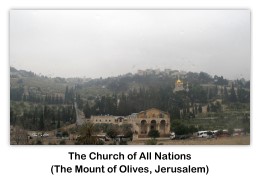

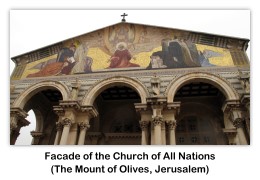


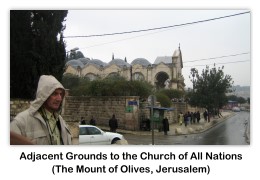

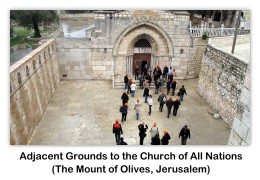
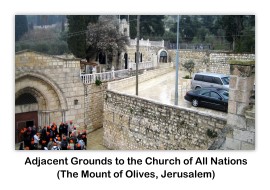
History
The current church rests on the foundations of two earlier ones, that of a small 12th century Crusader chapel abandoned in 1345, and a 4th century Byzantine basilica, destroyed by an earthquake in 746. In 1920, during work on the foundations, a column was found two meters beneath the floor of the medieval Crusader chapel. Fragments of a magnificent mosaic were also found. Following this discovery the architect immediately removed the new foundations and began excavations of the earlier church. After the remains of the Byzantine era church were fully excavated plans for the new church were altered and work continued on the current basilica from April 19, 1922 until June, 1924 when it was consecrated.
Use by Other Denominations — An open altar located in the gardens of the church is used by many Christian denominations including followers who are Roman Catholic, Eastern Orthodox, Armenian Apostolic, Protestant, Lutheran, Evangelical, Anglican, and any other version of Christianity or Orthodoxy that is culturally unique to any particular nation.
Design and Construction — The chapel was built between 1919 and 1924 using funds donated from many different countries. The respective coat-of-arms of each donating country are incorporated into the glass of the ceiling, each in a separate, small dome, and also into the interior mosaics. The countries honored in this way are; starting from the left side, beginning with the apse: Argentina, Brazil, Chile and Mexico; in the middle of the church are memorialized: Italy, France, Spain and the United Kingdom, and to the right: Belgium, Canada, Germany, and the United States of America. The mosaics in the apses were donated by Ireland, Hungary, and Poland. The crown around the bedrock itself was a gift of Australia. These multi-national donations give the church its present title as the Church of “All Nations.”
Two types of stone were used in the construction of the church: the interior utilizes a stone from the quarries at Lifta, north-west of Jerusalem; and the exterior, a rose colored stone from Bethlehem. The building is divided by six columns into three aisles. This design gives the impression of one large open hall. Violet-colored glass was used throughout the church to evoke a mood of depression analogous to Christ's agony, and the ceiling is painted a deep blue to simulate a night sky.
The façade of the church is supported by a row of Corinthian columns set below a modern mosaic depicting Jesus Christ as mediator between God and man. The designer of the façade mosaic was Professor Giulio Bargellini. The bubble-domed roof, thick columns, and façade mosaic give the church a Byzantine look architecturally.
The church was designed by architect Antonio Barluzzi, the architect of several shrines and sanctuaries built during the first half of the 20th century. He is also known for some of his other works in Jerusalem, such as the sanctuary church of Dominus Flevit on the Mount of Olives, the Church of the Visitation at Ein Karem, and the Church of the Flagellation on the Via Dolorosa. St. Lazarus' in Bethany is another example of Barluzzi's designs. The church is currently held in trust by the Franciscan Custody of the Holy Land.
The Garden of Gethsemane
The Garden of Gethsemane is located adjacent to The Church of All Nations at the foot of the Mount of Olives in Jerusalem. It is most famous as the place where Jesus and his disciples prayed the night before Jesus' crucifixion. According to Luke 22:43-44, Jesus' anguish in Gethsemane was so deep that "his sweat was as it were great drops of blood falling down to the ground." According to the Eastern Orthodox Church tradition, Gethsemane is the garden where the Apostles buried the Virgin Mary for three days before her dormition.
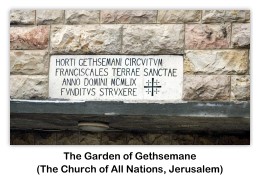
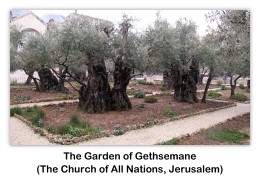
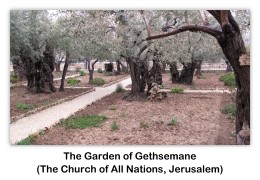
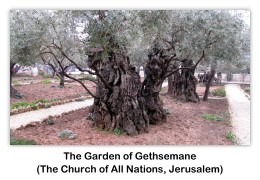
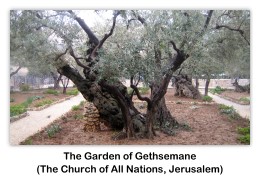
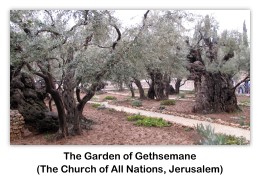
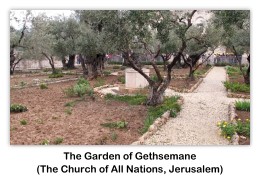


While tradition locates Gethsemane on the lower slopes of the Mount of Olives, the exact spot remains unknown. According to the New Testament it was a place that Jesus and his disciples customarily visited, which allowed Judas to find him on the night of his arrest. Overlooking the garden is the Church of All Nations, also known as the Church of the Agony, built on the site of a church destroyed by the Sassanids in 614 CE, and a Crusader church destroyed in 1219 CE. Nearby is the Russian Orthodox Church of St. Mary Magdalene with its golden, onion-shaped domes (Byzantine/Russian style), built by Russian Tsar Alexander III in memory of his mother.
The Garden of Gethsemane was a focal site for early Christian pilgrims. It was visited in 333 CE by the anonymous “Pilgrim of Bordeaux”, whose Itinerarium Burdigalense is the earliest description left by a Christian traveler in the Holy Land. In his Onomasticon, Eusebius of Caesarea notes the site of Gethsemane is located “at the foot of the Mount of Olives”, and he adds that “the faithful were accustomed to go there to pray.” Ancient olive trees growing in the garden are said to be 900 years old.
The Skytamer Archive
This concludes our visit to the Church of All Nations and the Garden of Gethsemane. To learn more about The Church of All Nations and the Garden of Gethsemane, visit the Wikipedia sites noted below. Please remember that the photos used on this webpage are copyrighted © by Skytamer Images, and are for your personal use only. Commercial use of these images requires written permission from Skytamer Images.
References
- Shupek, John, “Skytamer Images Photo Archive”
- Google Earth, “Satellite Image”
- Wikipedia, “Church of All Nations”
- Wikipedia, “Garden of Gethsemane”
Copyright © 1998-2019 (Our 21st Year) Skytamer Images, Whittier, California
All rights reserved


























